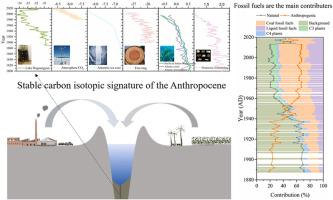当前位置:
X-MOL 学术
›
Appl. Geochem.
›
论文详情
Our official English website, www.x-mol.net, welcomes your feedback! (Note: you will need to create a separate account there.)
Source appointment of δ13C in sediments of a maar lake in southern China: Implications of fossil fuel CO2 emissions
Applied Geochemistry ( IF 3.4 ) Pub Date : 2024-03-09 , DOI: 10.1016/j.apgeochem.2024.105950 Meiling Guo , Yongming Han , Weiguo Liu , Yunning Cao , Dewen Lei , Weijian Zhou , Zhisheng An
Applied Geochemistry ( IF 3.4 ) Pub Date : 2024-03-09 , DOI: 10.1016/j.apgeochem.2024.105950 Meiling Guo , Yongming Han , Weiguo Liu , Yunning Cao , Dewen Lei , Weijian Zhou , Zhisheng An

|
Stable carbon isotopes (δC) in lake sediments can record changes in CO emissions from fossil fuels (FFs) combustion; however, the exact proportion of δC changes caused by FFs combustion remains unclear. Here, taking the Huguangyan Maar Lake (HGY) located in low latitude with high intensity of human activities in southern China as an example, we used the MixSIAR Bayesian stable isotope mixing model to trace the source change of δC in the HGY sediments over the past 130 years. The δC value, ranging from −20.23‰ to −24.29‰, with an average of −22.39 ± 1.5‰, displayed a continuous downward trend from the bottom to top throughout the core, with the fastest decline occurring between 1950AD and 1996AD. Quantitative source appointment indicates that the contribution of FFs sources to δC depletion in the HGY sediments has increased nearly three-fold over the past 130 years, from 18.6% to 67.8%, which may be related to the Suess Effect of the C-depleted FFs burning. The increase in δC in HGY sediments in the past decade was consistent with the increase in δC–CO emitted by global fossil-fuel consumption, and was also related to the decrease in fossil fuels consumption caused by China's Clean Air Act. This study demonstrates that the isotope traceability model is helpful for source appointment of δC in lake sediments and that the δC in maar lake sediments can be used to trace CO emissions from global FFs combustion. This therefore provides new insights on the carbon cycle during the Anthropocene.
更新日期:2024-03-09



























 京公网安备 11010802027423号
京公网安备 11010802027423号